The AMD Radeon R9 380X Review, Feat. ASUS STRIX
by Ryan Smith on November 23, 2015 8:30 AM EST- Posted in
- GPUs
- AMD
- Radeon
- Asus
- Radeon 300
Power, Temperature, & Noise
As always, last but not least is our look at power, temperature, and noise. Next to price and performance of course, these are some of the most important aspects of a GPU, due in large part to the impact of noise. All things considered, a loud card is undesirable unless there’s a sufficiently good reason – or sufficiently good performance – to ignore the noise.
Unfortunately we don’t have any tools that can read the GPU voltage on the ASUS card, so we’ll jump right into average clockspeeds.
| Radeon R9 380X Average Clockspees | |||
| Game | ASUS R9 380X (OC) | ASUS R9 380X (Ref) | |
| Max Boost Clock | 1030MHz | 970MHz | |
| Battlefield 4 |
1030MHz
|
970MHz
|
|
| Crysis 3 |
1030MHz
|
970MHz
|
|
| Mordor |
1030MHz
|
970MHz
|
|
| Dragon Age |
1030MHz
|
970MHz
|
|
| Talos Principle |
1030MHz
|
970MHz
|
|
| Total War: Attila |
1030MHz
|
970MHz
|
|
| GRID Autosport |
1030MHz
|
970MHz
|
|
| Grand Theft Auto V |
1030MHz
|
970MHz
|
|
The ASUS R9 380X has no problem holding its full boost clockspeed in games, both at its stock speed of 1030MHz and when downclocked to 970MHz.
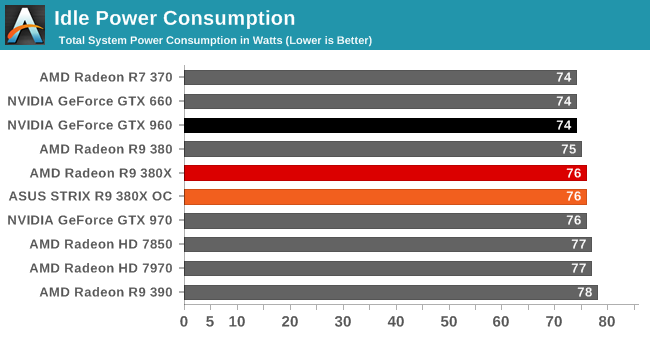
Starting with idle power consumption, the ASUS card comes in right where we’d expect it. 75-76W is typical for a Tonga card on our GPU testbed.

Moving on to power consumption under Crysis 3, like so many other aspects of R9 380X, its performance here is very close to the original R9 380. Power consumption is up slightly thanks to the additional CUs and the additional CPU load from the higher framerate, with the reference clocked R9 380X coming in at 299W, while ASUS’s factory overclock pushes that to 304W.
The problem for AMD is that this is smack-dab in GTX 970 territory. Meanwhile the GTX 960, though slightly slower, is drawing 74W less at the wall. R9 380 just wasn’t very competitive on power consumption compared to Maxwell, and R9 380X doesn’t do anything to change this. AMD’s power draw under games is essentially one class worse than NVIDIA’s – the R9 380X draws power like a GTX 970, but delivers performance only slightly ahead of a GTX 960.
The one bit of good news here for AMD is that while the power consumption of the R9 380X isn’t great, it’s still better balanced than the R9 390. With AMD opting to push the envelope there to maintain price/performance parity with the GTX 970, while the R9 380X is a fair bit slower than the R9 390, it saves a lot of power in the process. And for that matter the R9 380X shows a slight edge over the 7970, delivering similar gaming performance for around 16W less at the wall.
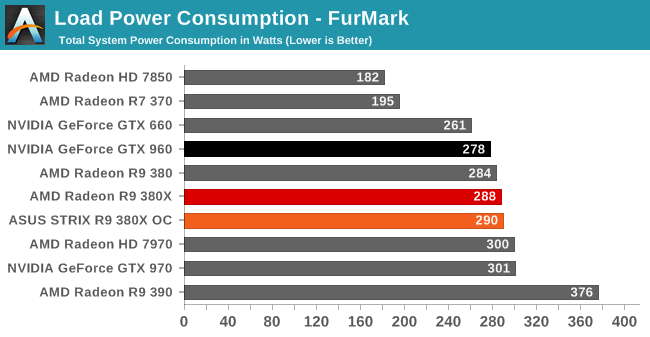
Moving over to FurMark our results get compressed by quite a bit (we’re using a GTX 960 with a fairly high power limit), but even then the R9 380X’s power consumption isn’t in AMD’s favor. At best we can say it’s between the GTX 960 and GTX 970, with the former offering performance not too far off for less power.
Otherwise as was the case with Crysis 3, the R9 380X holds a slight edge over the 7970 on power consumption. This despite the fact that the R9 380X uses AMD’s newer throttling technology, and consequently it gets closer to its true board limit than the 7970 ever did.
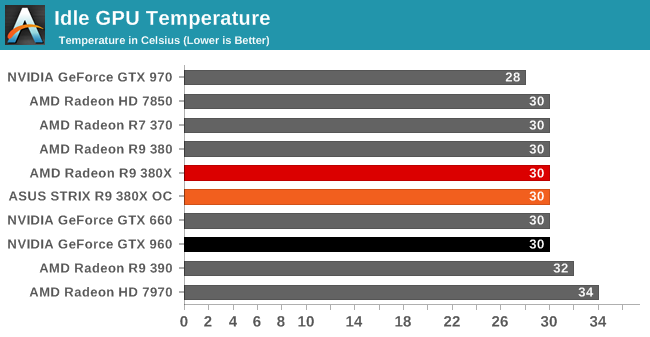
With idle temperatures ASUS’s 0db Fan technology doesn’t hamper the R9 380X at all. Even without any direct fan airflow the STRIX R9 380X holds at 30C.
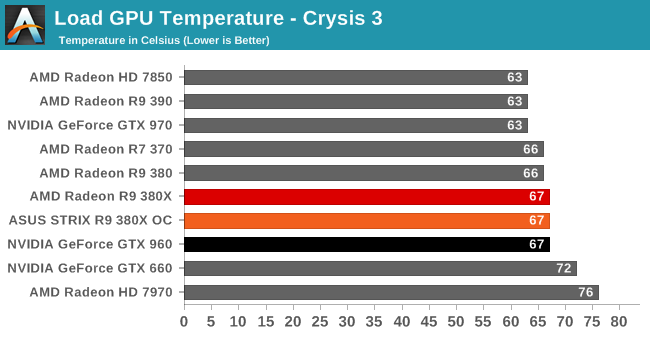
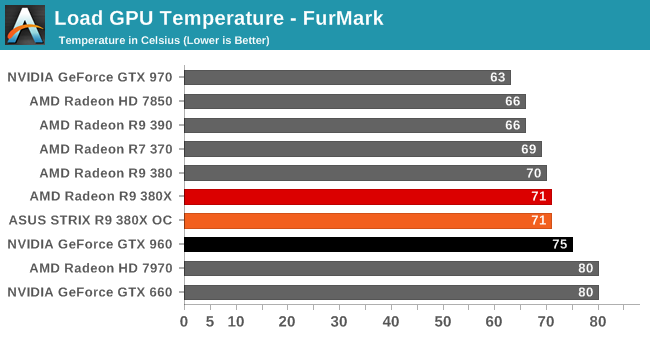
Load temperatures also look good. ASUS’s sweet spot seems to be around 70C – right where we like to see it for an open air cooled card – with the R9 380X reaching equilibrium at 67C for Crysis 3 and 71C for FurMark.
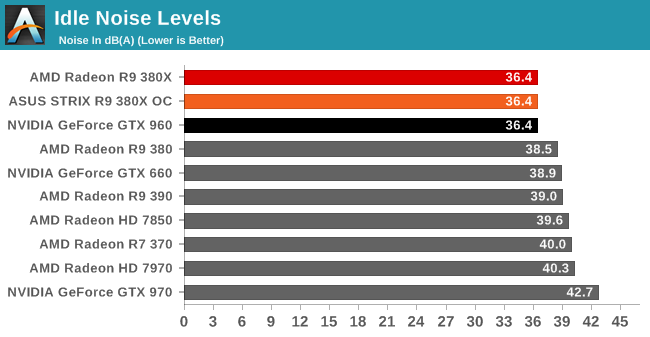
Finally with idle noise, the zero fan speed idle technology on the STRIX lineup means that the STRIX R9 380X gets top marks here. At 36.4dB the only noise coming from our system is closed loop liquid cooler for the CPU. The video card is completely silent.
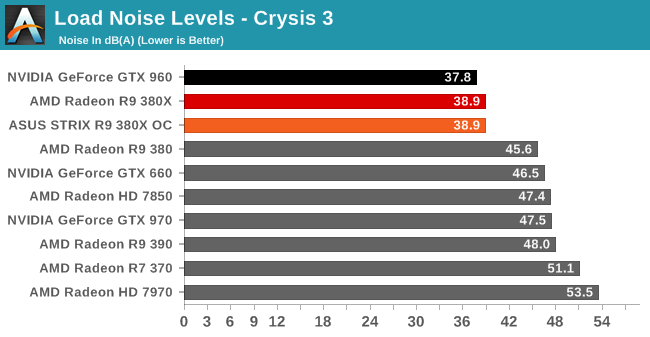
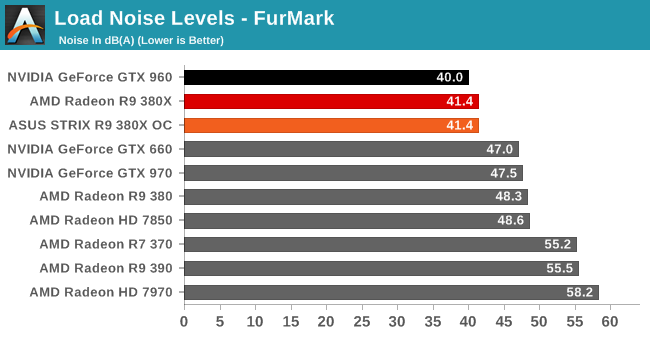
Shifting over to load noise levels then, the STRIX R9 380X continues to impress. With Crysis 3 the card tops out at 38.9dB – less then 3dB off of our noise floor – and that goes for both when the card is operating at AMD’s reference clocks and ASUS’s factory overclock. At this point the STRIX R9 380X is next-to-silent; it would be hard to do too much better without using an entirely passive cooling setup. So for ASUS to dissipate what we estimate to be 175W or so of heat while making this little noise is nothing short of impressive.
Meanwhile with FurMark the ASUS card needs to work a bit harder, but it still offers very good results. Even with the card maxed out we’re looking at just 41.4dB. The STRIX R9 380X isn’t silent, but it gets surprisingly close for such a powerful card.










101 Comments
View All Comments
SpartyOn - Monday, November 23, 2015 - link
My 770 is at 1400 MHz core / 7940 MHz memory; trust me, neither the GTX 960 or this 380x are beating me and I'm not digging into my wallet until Pascal comes out. It was tough when the GTX 980 Ti was released, but I'm sticking to my guns.At 1080p, which is where the 960 and 380x should be competing (because if you buy either of these for 1440p+, you're a moron), if they had gotten a 960 4GB for comparison, there wouldn't be much difference. You can get a 960 4GB, which is a one year old card, for less than $200 and it's essentially just as good at stock. The few frames the 380x wins in this review is mostly due to the VRAM limit on the 960 2GB.
Plus you can overclock a 960 to insane levels, so why spend $229 on the 380x when you can spend $180 on a GTX 960 4GB and overclock it if you want more speed?
Sushisamurai - Monday, November 23, 2015 - link
Errr... Isn't the 960 a rebadge of the 770?Sushisamurai - Monday, November 23, 2015 - link
Note: rebadge in the sense that the hardware is super similar, minus the maxwell gen 2 featuresSushisamurai - Monday, November 23, 2015 - link
Oops I lied. The 770 is not comparable to the 960; I'm assuming it's better. Mind u, the 280X and 770 were comparable back in the day.silverblue - Monday, November 23, 2015 - link
Yep, as the 770 is essentially a tweaked 680, which traded blows with the 7970/7970GE,CiccioB - Tuesday, November 24, 2015 - link
The sad thing is how all you make comparisons on this kind of technology. GPU scales well when made fat. So the point of "performance" is really moot when doing comparisons. It's like saying that the 750Ti is the same as a GTX480 because they perform similarly.This card (like all the new AMD 300 series) are simply fat, bloated, clocked at their limit GPUs that are sold under cost to compete with smaller more efficient architectures created by the competition (that is selling them at premium prices).
This 380X card is a complete fail in trying to make AMD advance in its fight. Competition has done marvelous things meanwhile: they came with a GPU, the GM106, which is half the GK104 in term of size and power consumption, and has the same performances. This is the progress the competition did while AMD passed from GCN 1.0 to GCN 1.2, which has only few tricks and hacks but nothing really good to bring that already obsolete architecture to the new level of competition.
Sorry, but if you are excited by this kind of "evolution" and you do not understand where this has brought "your favorite company" to, you really deserve to stay a generation back in terms of innovations. And be happy of this Tonga which will be sold for few bucks in few month and be completely forgotten when Pascal will annihilate it at it first iteration.
britjh22 - Monday, November 23, 2015 - link
Comparing a 2.5 year old card that cost $450-500 against a $230 card.... and complaining if AMD is even trying... your bias is showing sir. You shouldn't feel the need to upgrade yet in my opinion, unless of course your card is being crippled by NVIDIA's drivers, whoops!tviceman - Monday, November 23, 2015 - link
GTX 770 launched at $399, not $450. Interestingly, the GTX 770 was a smaller chip and drew less power. So, tossing the consumer economics aside, SpartyOn raises a good point.britjh22 - Monday, November 23, 2015 - link
The 770 2GB launched at $399, but the 4gb launched at anywhere from $450 to $500 depending on the model.200380051 - Monday, November 23, 2015 - link
The power consumtion of the 380X under load is lower with Furmark than it is with Crysis 3, while it is the opposite with the GTX 960. Any thoughts on that?